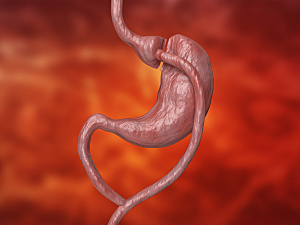Roux-en-Y gastric bypass (RYGB) is now established to be superior to lifestyle changes or medical therapy in managing type 2 diabetes. In addition to hormonal and physiologic adaptations, an important mechanism of diabetes remission is that RYGB isolates the proximal bowel from nutrient exposure.
Since many patients with diabetes are ineligible for RYGB or decline it, researchers at Brigham and Women’s Hospital developed an orally administered gut barrier coating—a much less invasive approach to improving glucose homeostasis. In Nature Materials they reported a single dose of LuCI (short for Luminal Coating of the Intestine) lowered glucose response in rodents.
Now the team has demonstrated longer-term benefits of LuCI on weight and insulin sensitivity in a rat model of diet-induced obesity. Tammy Lo, MBBS, of the Laboratory for Surgical and Metabolic Research at the Brigham, Yuhan Lee, PhD, a materials scientist in the Department of Anesthesiology, Perioperative and Pain Medicine, Jeffrey M. Karp, PhD, distinguished chair in Clinical Anesthesiology, Perioperative and Pain Medicine, Ali Tavakkoli, MD, chief of the Division of General and Gastrointestinal Surgery, and colleagues detail the findings in Metabolism.
Methods
After a week of eating normal chow, male rats were randomly assigned to receive a daily weight-dependent dose of LuCI or normal saline for five weeks. The animals were given free access to a high-fat diet.
Key Efficacy Results
At the end of treatment the LuCI group exhibited multiple differences from the control group in metabolic parameters:
- Weight—Despite no differences between groups in food intake, the LuCI group weighed 8% less (P<0.05)
- Peak glucose level—18% lower with LuCI (128 vs. 156 mg/dL; P<0.01)
- Fasting insulin—5.3-fold lower with LuCI (212 vs. 1,133 pg/mL; P<0.001)
- Incretins (gut hormones)—GLP-1 levels were 1.7-fold higher with LuCI, and gastric inhibitory polypeptide levels were 2.1-fold higher
- Appetite-regulating hormones—Fasting ghrelin levels were 2-fold lower with LuCI (29 vs. 57 pg/mL; P<0.01), and fasting leptin levels were 1.8-fold lower (303 vs. 553 pg/mL; P<0.05)
LuCI also showed potential for improved cardiovascular health:
- Total serum cholesterol levels—66 vs. 88.5 mg/dL (P=0.0214)
- Circulating low-density lipoprotein cholesterol concentration—48 vs. 73 mg/dL (P=0.0082)
- Circulating LDL particle concentration—623 vs. 852 mmol/L (P=0.0324)
Safety
LuCI-treated rats did not have diarrhea or other noticeable side effects and there were no substantial behavioral differences between the groups.
Ready for Clinical Translation
LuCI is bioengineered from sucralfate, an FDA-approved drug that selectively coats gastric and duodenal ulcers. The modifications cause LuCI to form a continuous coating on the healthy gastrointestinal mucosa. When exposed to gastrointestinal fluid, it forms a sticky paste, independent of pH, that blocks nutrient contact.
In its powder form, LuCI can be placed inside a capsule and delivered to a designated portion of the gastrointestinal tract. Its effect is transient and there appears to be no systemic absorption of the drug.
These properties make LuCI a candidate for early therapeutic intervention in overweight and obesity. It may prevent the progression of diabetes and possibly even lead to disease remission, as is seen after RYGB.
LuCI is being advanced to the clinic by AltrixBio and clinical trials are expected to start within a year.
